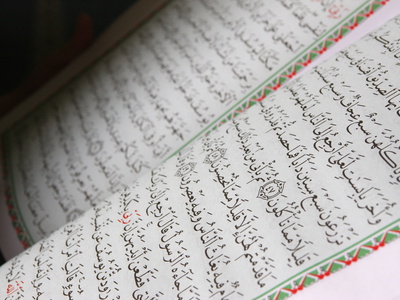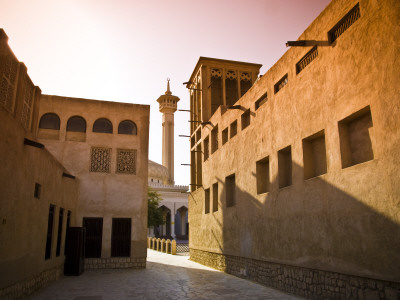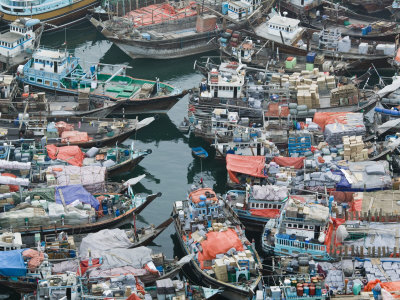United Arab Emirates
Dubai
Archaeological finds suggest that Dubai was inhabited since 3000 B.C.E. Other evidence links the United Arab Emirates (as they are now called) to the Bronze Age Magan civilization. Dubai's location between the Mediterranean and Indian Ocean made it a natural for trading. Magan ships sailed to Babylonia, Mesopotamia and beyond, trading copper from Oman and pearls from the mouth of Dubai Creek. After the Magan civilization waned (about 2000 B.C.E.), trade routes were well-established and continued.
There are several theories as to how Dubai was named.
- One theory is that the word Dubai is a combination of the Farsi words for two and brothers, the latter referring to Deira and Bur Dubai.
- Others believe that "Dubai" was so named by people who considered its souq a smaller version of a thriving market named "Daba."
- Another possibility is that the name came from a word meaning money - people from Dubai were commonly believed to have money because it was a prosperous trading centre.
There is another town named Dubai in the Al Dahna' region of Saudi Arabia, between Riyadh and Ad Dammam.
Map of Dubai, Middle East |
In 1095, Dubai was mentioned in the Arabic book Mojam Ma Ostojam men Asmae Al belaad wal Mawadhea by Abdullah Bin Abdu Aziz Al Bakri Al Andalasi. He refers to Dubai as a vast place. Merchant ships had been sailing to and from the port between 750 and 1258 C.E.
Koran, Dubai, United Arab Emirates |
By the 16th century, the Portuguese included Dubai in their outreach to control trade in world ports, including the lucrative Persian Gulf trade. Of course, they were followed by the French, Dutch and British, who were also attempting to control ports valuable to their trade. By 1766, the British had gained control.
In the 18h Century, Dubai was a small fishing and trading village.
Muslim Man Praying Dubai, United Arab Emirates, Middle East |
In 1833, 800 members of the Bani Yas tribe of what is now Saudi Arabia, led by Maktoum bin Butti (founder of the Al-Maktoum dynasty that still rules the emirate) settled in the Bur Dubai area. The creek was a natural harbor and Dubai soon became a center for the fishing, pearl and sea trades.
Although he was young, Sheikh Maktoum bin Buti ruled Dubai effectively and it grew into a flourishing coastal town. As the population grew, Dubai branched into three distinct areas: Deira was the largest and the main commercial centre. On the western bank, Bur Dubai and Shindagha were separated by a wide stretch of sand called Ghubaiba, which would flood during high tide. Shindagha, situated on a narrow strip of land separating the sea from the creek, was the smallest area and the main residential district. The ruling sheikhs traditionally lived here and the late Sheikh Saeed's house is still standing. Shindagha was probably the site of the original Bani Yas village.
Donkeys and camels provided transportation on land. Crossing the creek meant a long and arduous journey around the end of the creek or a ride in an abra, a small wooden boat that ferries passengers to this day. Abras were also used to transport people to ships.
In 1835, a Maritime Truce was imposed by the British.
By the end of the 1800s, Deira's souq, the town's public market, was lined with narrow, covered passageways. With 350 shops of commodities from around the world, it was the largest market in the region and drew steady visitors and businessmen. Many of the craftsman in the suq had no shop, but worked on a vacant piece of ground as close as possible to their clients. They were known by name, and the cry would go round the suq, "Where is Hassan the mattress-maker?" until it reached him and he was able to make contact with the potential client.
Historic Bastakia Quarter in Bur Dubai Glenn Beanland |
In 1890, Kanoo (now one of the biggest shipping agencies in the Middle East and one of the largest independent, family owned companies in the Gulf Region with 11,000 ship calls annually) was established in Bahrain by Haji Yusuf Bin Ahmed Kanoo. The family-owned company used Dubai's Creek to drop off and pick up goods before other ports were built.
Aerial View of Dhow Wharves, Deira, Dubai United Arab Emirates Walter Bibikow |
With a thriving port and market, Dubai's residents enjoyed a higher standard of living than their neighbours in the region
Shaikh Maktoum decided to capitalize on the opportunity. In 1892 Shaikh Maktoum signed an exclusive business deal with the British. During this time, pearl fisherman were offered tax breaks, followed by full tax exemptions in 1894. Traders from around the world took advantage of the offer.
In 1903, the Shaikh convinced the Indian based British Steamship Line to transfer their port of call to the up and coming hub of Dubai. Until then, the British Steamship Line served British, Indian and local traders in the region. Official British facilities were not built in the area until 1932 when Imperial Airways built a rest house in Sharjah for passengers and crew en route between London and India.
1899. World's Fleet. Boston Daily Globe
Lloyds Register of Shipping gives the entire fleet of the world as 28,180 steamers and sailing vessels, with a total tonnage of 27,673,628, of which 39 perent are British.
| Great Britain | 10,990 vessels, total tonnage of 10,792,714 |
| United States | 3,010 vessels, total tonnage of 2,405,887 |
| Norway | 2,528 vessels, tonnage of 1,604,230 |
| Germany | 1,676 vessels, with a tonnage of 2,453,334, in which are included her particularly large ships. |
| Sweden | 1,408 vessels with a tonnage of 643, 527 |
| Italy | 1,150 vessels |
| France | 1,182 vessels |
For Historical Comparison
Top 10 Maritime Nations Ranked by Value (2017)
| Country | # of Vessels | Gross Tonnage (m) |
Total Value (USDbn) |
|
|---|---|---|---|---|
| 1 | Greece | 4,453 | 206.47 | $88.0 |
| 2 | Japan | 4,317 | 150.26 | $79.8 |
| 3 | China | 4,938 | 159.71 | $71.7 |
| 4 | USA | 2,399 | 55.92 | $46.5 |
| 5 | Singapore | 2,662 | 64.03 | $41.7 |
| 6 | Norway | 1,668 | 39.68 | $41.1 |
| 7 | Germany | 2,923 | 81.17 | $30.3 |
| 8 | UK | 883 | 28.78 | $24.3 |
| 9 | Denmark | 1,040 | 36.17 | $23.4 |
| 10 | South Korea | 1,484 | 49.88 | $20.1 |
| Total | 26,767 | 87.21 | $466.9 | |










 Copyright ~ 1998-2018.
Copyright ~ 1998-2018. 